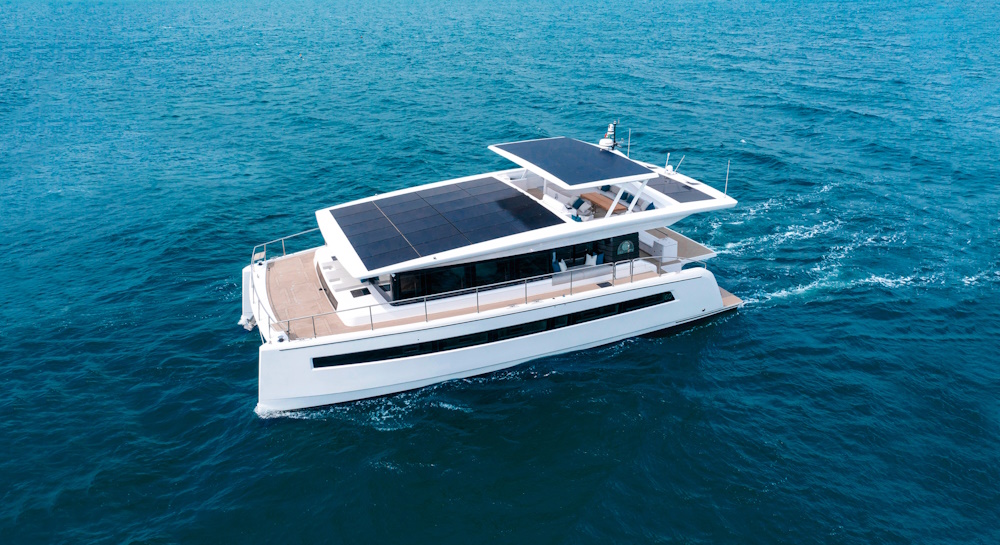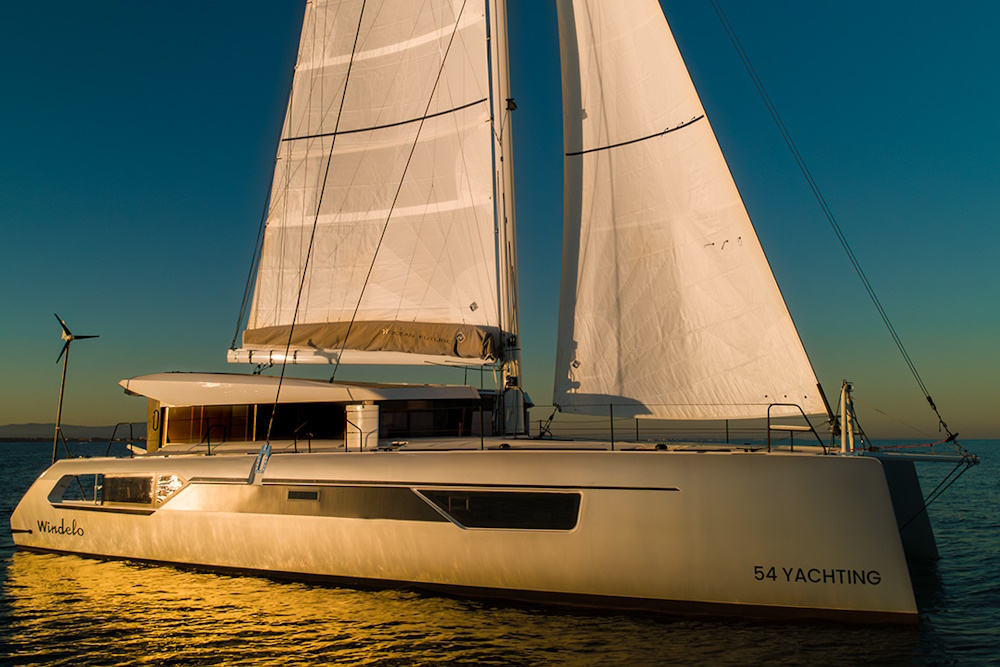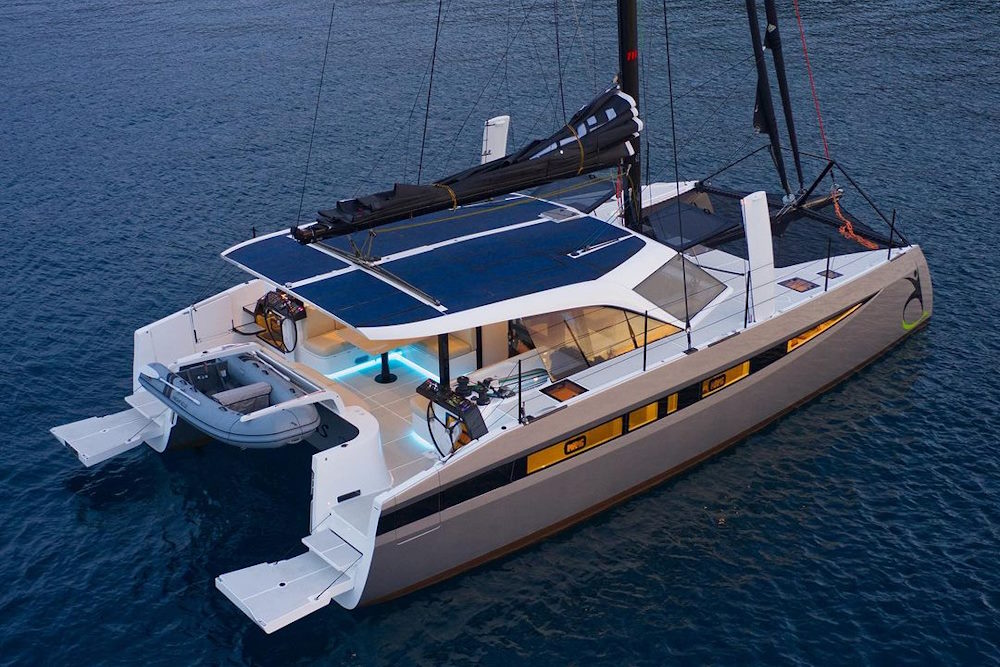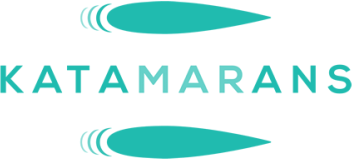Electric vs. Diesel Power on Catamarans
Electric vs. Diesel Power on Sailing Yachts: A Comparison for Catamarans
The debate between electric and diesel power on sailing yachts, particularly on catamarans thanks to their large “real estate” for solar panels, is heating up as technological advances make electric propulsion more viable.

Choosing between the two systems involves weighing factors like cost, reliability, and environmental impact. In this article, we explore this evolving topic, focusing on the pros and cons of each system and delving into some of the latest hybrid technologies.
And just remember, the ultimate aim of a sailing catamaran is to sail! In which case you don´t need your engines.
Arguably, your priority for an eco-boat should be to start sailing sooner and for longer, whatever the conditions. If you are sailing at windspeed in 6 knots of wind, well that´s a huge win. And for that, you will need an efficient boat that is light and cuts through the water efficiently.
Introduction
Modern sailing catamarans are increasingly incorporating electric propulsion systems, signalling a shift in the industry.
Brands like Windelo and Silent Yachts are fully committed to these new technologies, and more established brands such as Fountaine Pajot are making a move.
Traditional diesel engines have been the norm for decades, offering reliability and ease of use. However, electric systems, bolstered by advancements in battery technology and renewable energy integration, are challenging the status quo.
So, which system is right for your project? Let’s dive into the details.
Pros and Cons of Electric Boats
Pros:
- Eco-Credentials: Electric propulsion produces no direct emissions, making it environmentally friendly, especially when paired with renewable energy sources like solar and wind.
- Quiet Operation: Electric motors are nearly silent, enhancing the onboard experience for those who value peace and quiet. Who doesn’t?
- Lower Running Costs: Electricity is generally cheaper than diesel, and with renewable energy sources onboard, operational costs can be minimal.
- Lower Maintenance: Electric motors have fewer moving parts than diesel engines, reducing maintenance complexity and costs.
- Future-Proofing: With increasing regulations on emissions, electric propulsion aligns with emerging standards and trends.
Cons:
- Higher Initial Outlay: Electric systems can be more expensive upfront due to the cost of batteries, motors, and renewable energy components.
- Range Limitations: Depending on battery capacity, range can be limited compared to diesel engines, especially under power-intensive conditions.
- Resale Value: While improving, the market for electric yachts is still developing, potentially impacting resale value.
- Reliability Concerns: Electric systems rely heavily on batteries, which can degrade over time or under harsh conditions. Protecting the connections is key.
Latest Hybrid Electric Systems
Windelo 54: Serial Hybrid

The Windelo 54 employs a serial hybrid system, where an electric engine is the primary source of propulsion. A battery bank stores energy, which can be recharged using renewable sources or a backup generator. Key features include:
- Efficient Energy Use: The generator only runs to charge the batteries, not for direct propulsion, minimising fuel consumption.
- Regeneration: The system can regenerate power through hydrogeneration while sailing.
- Sustainability: This setup pairs seamlessly with solar panels and wind turbines, enhancing eco-credentials.
HH 44: Parallel Hybrid

- The HH 44 uses a parallel hybrid system, combining a diesel engine and an electric motor on the same shaft. Either system can operate independently or in tandem. Highlights include:
- Flexibility: You can choose between diesel and electric power depending on conditions.
- Backup Reliability: Diesel ensures propulsion is always available, even if the batteries are depleted.
- Performance: Offers higher torque and efficiency when both systems work together.
Pros and Cons of Each Hybrid System
Serial Hybrid:
Pros: Greater efficiency when running on electric; ideal for eco-conscious sailors.
Cons: Heavy reliance on battery capacity and renewable energy sources.
Parallel Hybrid:
Pros: Reliable and versatile; better suited for mixed-use scenarios.
Cons: Slightly less efficient when switching between systems frequently.
Understanding Power, Storage, and Performance
Power and Battery Storage Metrics
Kilowatts (kW): Electric motors are rated in kilowatts. For example, a 20 kW motor power output is roughly equivalent to a 27 HP diesel engine. But, they are more efficient and tend to use shaft drive instead of sail drives (also more efficient with less maintenance).
Kilowatt-Hours (kWh): Battery capacity is measured in kWh. A 50 kWh battery provides 50 kW for one hour or 10 kW for five hours.
Amp-Hours (Ah): Used to measure battery storage in 12V or 48V systems; can be converted to kWh for comparison. So, kWh = (Ah x V) / 1,000.
kWh to Ah Convertor/Calculator
Ah to kWh Converter
Real-Life Examples
Windelo 54: Equipped with a 54 kWh battery bank, this catamaran can cruise silently for several hours before recharging.
HH 44: Combines a smaller battery system with the option to switch to diesel for extended range.
Comparing to Diesel
A traditional catamaran with twin 50 HP diesel engines would burn around 10 litres of fuel per hour at cruising speed. To match this performance, an electric system would need approximately 75 kW of continuous power, requiring a significant battery capacity for extended cruising.
Power Regeneration: Solar, Hydro, and Wind
Solar Panels
Modern catamarans often feature big solar arrays. For example, a 5 kW solar system on a catamaran can produce around 20-30 kWh of energy on a sunny day—helping to recharge batteries for several hours of motoring.
Hydrogeneration
Electric motors can act as generators when under sail thanks to the props. Sailing at 8 knots, hydrogeneration can produce around 1-2 kW, depending on the system. This provides a steady charge to the batteries. Let´s say this gives you 24kWh over 24 hours.
Wind Turbines
While less efficient than solar or hydrogeneration, wind turbines can add supplementary power. A typical turbine generates 300-500 W in ideal wind conditions, enough to support smaller electrical loads.
Summary: What Does the Future Hold?
The future of electric propulsion on sailing catamarans is promising. New launches like the Fountaine Pajot 41 signal growing industry interest in hybrid and fully electric systems. Advances in battery technology, coupled with better renewable energy integration, are driving down costs and improving performance.
While diesel remains a reliable and familiar choice, electric systems offer a compelling alternative for eco-conscious sailors.
As technology continues to evolve, the gap between diesel and electric propulsion will narrow, making electric power an increasingly attractive option for both new builds and retrofits. The sailing catamaran industry is entering an exciting era, with innovation paving the way for more sustainable cruising.
